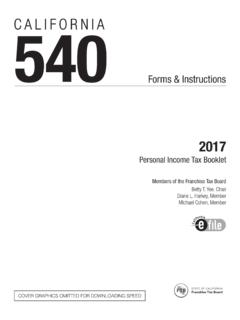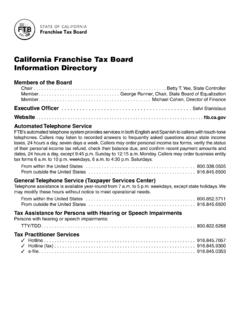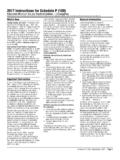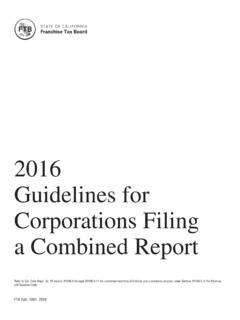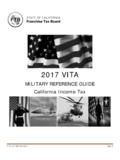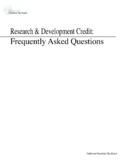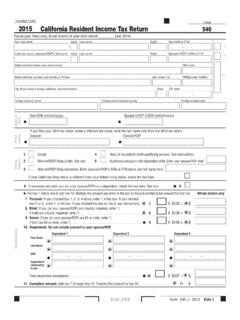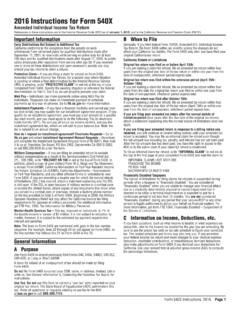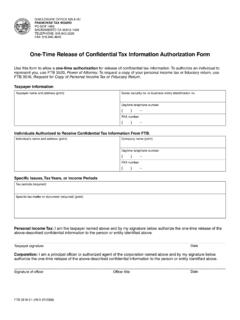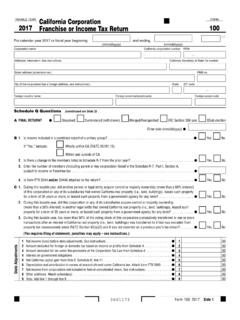Transcription of Chapter 7 Earnings & Profits and Distributions
1 Chapter 7 Earnings & Profits and Distributions Contents: a. Introduction b. E&P to be Determined on a Separate Company Basis c. Calculation of E&P for Federal Tax Purposes d. Calculation of E&P for California Tax Purposes e. Special Items to Consider in Computing E&P f. E&P of Foreign Corporations g. Internal Revenue Code (IRC) 482 Adjustments h. Impact of distribution on E&P i. Characterization of distribution received j. Determining California Tax Treatment of Dividends Source of Distributions k. dividend received from Foreign Corporations Partially Included in a Water's-Edge Combined Report l.
2 Dividends Paid from E&P Attributable to Excluded Income m. Maintenance of Books and Records n. Audit Tips o. Summary a. Introduction Congress has never provided a statutory definition of Earnings and Profits (E&P). Instead, a definition has developed over the years from a collection of administrative practices, court cases, revenue rulings, and adjustments required under IRC 312. In Henry C. Beck Co. v. Commissioner, (52 TC 1, (1969)), E&P was defined as an attempt to "approximate a corporation's power to make Distributions which are more than just a return of investment.
3 " A correct computation of E&P for federal and California tax purposes is necessary to determine the tax treatment of corporate Distributions ( , dividend , return of capital, or capital gain). California generally incorporates, "except as otherwise provided," the provisions of the IRC 301-385, which relate to corporate Distributions and adjustments. ( Revenue and Taxation Code (R&TC) 24451.) IRC 316 provides the definition of a dividend . IRC 316(a) states that any distribution of property is a dividend if paid from: Earnings and Profits of the taxable year, or Earnings and Profits accumulated since February 13, 1913 IRC 316(a) also provides for a last-in, first-out (LIFO) ordering rule.
4 It states that "Except as otherwise provided in this subtitle, every distribution is made out of Earnings and Profits to the extent thereof, and from the most recently accumulated Earnings and Profits ." California follows this E&P ordering rule for dividend payments, where dividends are deemed to be paid out of current E&P first, and then layered back on a LIFO basis. For Federal purposes the importance of E&P in the international area can be demonstrated by the effect it has on items such as: Subpart F Income taxable as a deemed dividend to the extent of the shareholder's pro-rata share of its current E&P.
5 (IRC 951.) Indirect Foreign Tax Credits E&P is a significant factor used to compute the deemed paid credit under IRC 902 and 960. For California purposes, the importance of E&P can be demonstrated by the effect it has on the following: dividend income includible in the water's-edge combined report. dividend elimination and deductions E&P is necessary to determine the correct amount of dividend elimination and dividend - received deductions allowed under R&TC 25106, 24410, and 24411. Controlled Foreign Corporations (CFCs) Current E&P is required to compute the inclusion ratio, which is used to determine the income and apportionment factors includible in a water's-edge combined report for unitary CFCs with Subpart F income pursuant to R&TC 25110(a)(2)(A)(ii).
6 Foreign Investment Interest Offset E&P is included in the computation of the unassigned foreign investment and total assets, which are components of the formula used to determine the interest expense that is attributable to foreign investments. (CCR 24344(c).) In general, computing the E&P of a corporation included in the waters-edge combined report begins with net income after state adjustments (Form 100W, page 1, line 18) and by making a series of positive and negative adjustments. For the most part, by incorporation of IRC 316, California follows the federal adjustments to arrive at Earnings and Profits : Add nontaxable income ( , Intercompany dividends) Add artificially created deductions ( , dividend received deductions) Subtract nondeductible expenses ( , federal income tax) Generally, E&P for federal tax purposes will be similar to E&P for California tax purposes.
7 However, E&P for federal and California may differ due to differences in elections and methods adopted in computing the respective taxable income ( , difference in basis caused by different elections under IRC 338 (sale of stock treated as asset sale), or IRC 1031 (like-kind exchanges)). For further discussion on differences between federal and California E&P calculations, see section d, of this Chapter . b. E&P to Be Determined on a Separate Company Basis Under California law, for purposes of determining the amount of E&P of a corporation, unitary attributes of a corporation are disregarded.
8 Income apportioned to a member of a unitary group by formula cannot form the basis for determining that corporation's E&P. For California tax purposes, E&P is determined on a separate company basis. (Appeal of Young's Market Company, 86-SBE-199, November 19, 1986.) The State Board of Equalization's decision in Young's Market Company was upheld by the California Court of Appeals. However, the Court of Appeals decision is not citable because it is an unpublished decision. The Board of Equalization decision is citable. For federal income tax purposes, every corporation has its own E&P account.
9 For corporations, other than a group of corporations electing to file a federal consolidated return, E&P of a subsidiary does not become E&P of its parent prior to a payment of those Earnings to the parent. However, a corporation that is a member of a consolidated group, must adjust its basis in stock of a subsidiary to account for increases and decreases in the E&P of the subsidiary. (Treasury Regulation (Treas. Reg.) ) Treas. Reg. requires "tiering adjustments" whereby the E&P of an upper tier corporation includes the E&P of lower tier subsidiaries.
10 As California does not conform to this regulation, any "tiering adjustments" ( , E&P of lower tier subsidiaries) should be excluded in computing E&P for California tax purposes. Remember, E&P is computed on a separate company basis using separate accounting and arms-length prices (as discussed in WEM 7, section g) for all intercompany transactions. c. Calculation of E&P for Federal Tax Purposes The primary function of E&P is to provide a measure of the economic income of a corporation available for distribution to its shareholders.
